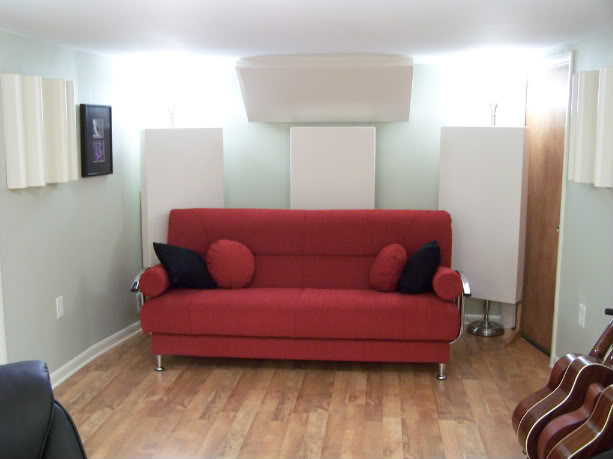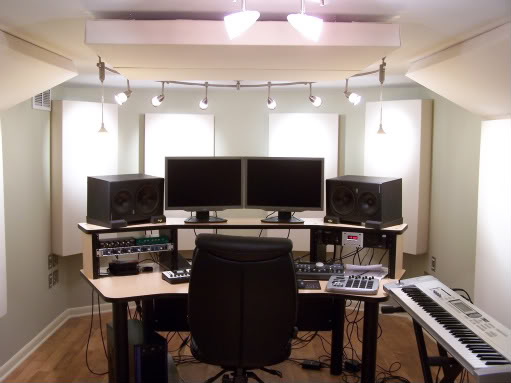Room modes are resonances at specific frequencies inside a room, which are related to the room’s dimensions. There are three types of modes in a room: axial, tangential, and oblique. The axial modes are easiest to visualize since they rely on just one dimension. The tangential modes rely on two dimensions, while the oblique modes rely on all three dimensions:
- Axial Modes are the strongest and many times the most noticeable, as they form between two parallel surfaces (one dimension, e.g., front wall to back wall, or side walls).
- Tangential Modes involve reflections between four surfaces (two dimensions), making them slightly weaker but still impactful.
- Oblique Modes form when sound waves reflect off all six surfaces (all 3 dimensions, four walls, floor, and ceiling) and are generally the least problematic but still contribute to room resonance.

For instance, if the length of the room is 17 feet, then the primary axial mode for that dimension will be at a frequency corresponding to the wavelength of that size. A 17-foot room length corresponds to about 66Hz, meaning the room will have an axial mode at 66Hz. Tangential and oblique room modes have less impact per mode but create additional interference that affects the sound quality.
 Sometimes the modal frequencies from these types of room modes will stack up at similar frequencies, common if 2 or more dimensions of the room are the same, or are even multiples of each other. Rooms of this shape will often have more several modal problems at fewer frequencies. They are less spread out across different frequencies.
Sometimes the modal frequencies from these types of room modes will stack up at similar frequencies, common if 2 or more dimensions of the room are the same, or are even multiples of each other. Rooms of this shape will often have more several modal problems at fewer frequencies. They are less spread out across different frequencies.
A room mode can cause both peaks and nulls (dips) in frequency response and will also dramatically affect decay times at those frequencies. When two or more sound waves meet in phase with each other, a peak occurs, making certain low-frequency notes unnaturally loud with a higher amplitude. When they meet out of phase, they cancel each other out, creating a null where certain bass frequencies nearly disappear. These effects, along with the wildly variable decay times at different frequencies, significantly degrade sound quality and make accurate audio playback difficult.
How Can I Check If My Room Has Modal Resonance Problems?
 All rooms will have modal resonance problems to some degree! The room’s shape plays a part in how the modes behave. Rooms with parallel walls (such as rectangular rooms) are easier to predict. But all rooms, regardless of shape, can be prone to modal issues. If you’re building a new room, choosing the size & shape will be critical on all levels, not just in dealing with room resonances.Understanding whether your room has significant modal issues is key to implementing effective acoustic treatment.
All rooms will have modal resonance problems to some degree! The room’s shape plays a part in how the modes behave. Rooms with parallel walls (such as rectangular rooms) are easier to predict. But all rooms, regardless of shape, can be prone to modal issues. If you’re building a new room, choosing the size & shape will be critical on all levels, not just in dealing with room resonances.Understanding whether your room has significant modal issues is key to implementing effective acoustic treatment.
Here are some methods to check for room modes:
- Use a Room Mode Calculator – A room mode calculator allows you to input your room dimensions and predict problematic resonant frequencies. These calculators are useful and include the needed constants such as the speed of sound. Predicting the modes is useful, but measurement tools like the Room EQ Wizard (REW) are even more useful because they measure what’s actually happening inside your room.
- Listen for Peaks and Nulls – Play a sine wave sweep from subwoofers or speakers and move around the room, noting which frequencies seem overly loud or disappear entirely at different locations.
Measure with an SPL Meter or Microphone – Using an SPL meter, or better yet a microphone and measurement software such as REW, can help you visualize the room’s frequency response and identify where peaks, dips, and excessive reverberation time occur.
What Is the Impact of Room Modes on Sound Quality?
Room modes significantly affect what you hear in the room. As always, acoustic treatments like sound absorption, diffusion, and bass trapping will mitigate the problems and restore your ability to accurately hear audio content.
- In Home Studios & Recording Studios – Modal issues result in inconsistent bass response, making it difficult to mix accurately. Without treating low frequencies, bass-heavy instruments like kick drums and bass guitars will sound imbalanced and it will be harder to be confident in your work without playing reference mixes on multiple systems (in the car, etc). Working in a well treated room with a neutral bass response will allow your mixes to translate everywhere.
- In Listening Rooms – Standing waves create unnatural boosts and dips in low-frequency response, affecting the clarity of loudspeakers and subwoofers. Again treatments will make things sound better.
In Small Rooms – Smaller spaces are particularly susceptible to axial room modes, as their dimensions are closer in size to the wavelengths of common low-frequency sounds. Most music has a lot more energy in the top 2 octaves of bass than in the bottom 2 octaves.
How to Acoustically Treat Room Modes
Addressing room resonances effectively requires strategic placement of bass traps, absorbers, and diffusers.
Step 1 – Treat the Corners of the Room
Since room modes are present in corners, bass traps should be placed in as many corners as possible, including the tri-corner areas where three surfaces meet. GIK Acoustics offers a wide selection of high-performance corner devices that target deep low-frequency buildup.
Step 2 – Address the First Reflection Points
Reflections from the side walls, front wall, rear wall, and ceiling should be controlled using acoustic panels. This improves direct sound clarity by minimizing flutter echoes and high-frequency ringing. Using thick panels in this application means they will also be effective at bass frequencies, so they will help with the modal problems as well.
Step 3 – Utilize Diffusion for a Balanced, Neutral Sound
While absorption panels are great for reducing decay times, including at bass frequencies, incorporating diffusion on the rear wall or upper side walls can help scatter high frequencies, preventing the room from sounding too “dead.” Without these tools, by the time we get enough thick panels for bass trapping into the room, we can sometimes over-absorb the treble. These and other GIK technologies allow us to deliver a more balanced, neutral room.
Step 4 – Optimize Speaker and Listening Position
The listening position should avoid areas where standing waves are strongest. Ideally, place speakers and seating where nodes (areas of cancellation) are minimized. Practically this means you don’t want listeners to be in the middle of the room’s length; typically being about ⅜ the length of the room rather than ½ will give better results.
Using Equalization to Correct Room Mode Problems
While physical room treatment is always the most effective approach, equalization (EQ) can be used to reduce extreme resonances. However, EQ cannot fix modal decay (how long certain frequencies linger), making a good bass trapping strategy a more effective long-term solution.
Final Thoughts
Understanding and treating room modes is crucial for achieving accurate room acoustics. Whether you’re designing a commercial recording studio, setting up a home studio, or improving your listening room or home theater, the right combination of bass traps, absorbers, and diffusion will significantly enhance your sound quality.
For a personalized room treatment plan, consult with a GIK Acoustics expert and use our Room Mode Calculator to diagnose problem frequencies in your space. Don’t let standing waves and resonant frequencies compromise your audio experience—take control of your sound today!





GIK Giveaway Viral Video Contest 2024
Room EQ Wizard TUTORIAL
How to set up and use REW In this video we show you how [...]
DIFFUSION Concepts Explained
How Acoustic Diffusers Work And Which One Is Right For You In this video [...]
Jan
The GIK Acoustic Advice
Get Your Room Sound Right For FREE! In this video we are giving a [...]
Jan
Designer Tips: The Significance of “Clouds” with Mike Major
When people reach out to us at GIK for acoustic advice, we never have any [...]
Jun
Designer Tips: The Importance of Coverage Area with James Lindenschmidt
The most important factor in acoustic treatment performance is coverage area. Or more specifically, the [...]
May
Designer Tips: Home Theaters and Acoustic Balance with John Dykstra
Without fail, one of the first things our clients say to us when we begin [...]
May
Summer Giveaway 2021 Vote
The GIK Acoustics Summer Giveaway Photo Contest 2021 invited customers to submit photos illustrating how [...]
Aug